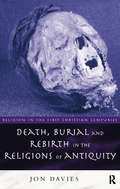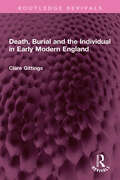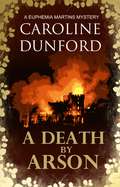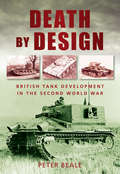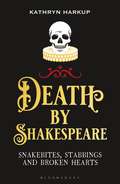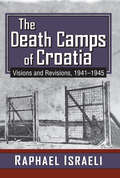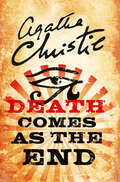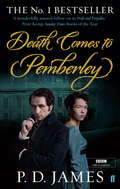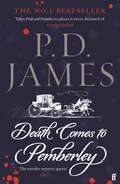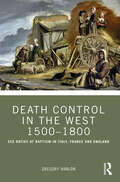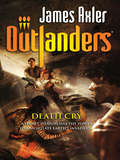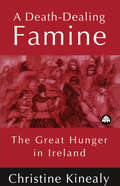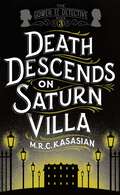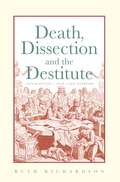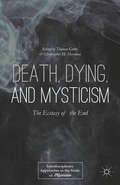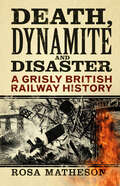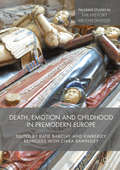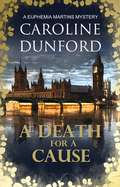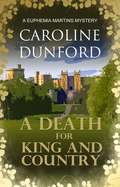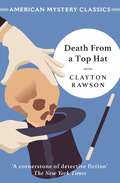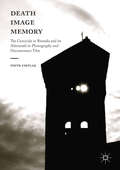- Table View
- List View
Death, Burial and Rebirth in the Religions of Antiquity (Religion in the First Christian Centuries)
by Jon DaviesIn Death, Burial and Rebirth in the Religions of Antiquity, Jon Davies charts the significance of death to the emerging religious cults in the pre-Christian and early Christian world. He analyses the varied burial rituals and examines the different notions of the afterlife. Among the areas covered are:* Osiris and Isis: the life theology of Ancient Egypt* burying the Jewish dead* Roman religion and Roman funerals* Early Christian burial* the nature of martyrdom.Jon Davies also draws on the sociological theory of Max Weber to present a comprehensive introduction to and overview of death, burial and the afterlife in the first Christian centuries which offers insights into the relationship between social change and attitudes to death and dying.
Death, Burial and the Individual in Early Modern England (Routledge Revivals)
by Clare GittingsFirst published in 1984, Death, Burial and the Individual in Early Modern England traces how and why the modern reaction to death has come about by examining English attitudes to death since the Middle Ages. In earlier centuries death was very much in the midst of life since it was not, as now, associated mainly with old age. War, plague and infant mortality gave it a very different aspect to its present one. The author shows in detail how modern concern with the individual has gradually alienated death from our society; the greater the emphasis on personal uniqueness, the more intense the anguish when an individual dies. Changes in attitudes to death are traced through alterations in funeral rituals, covering all sections of society from paupers to princes. This gracefully written book is a unique, scholarly and thorough treatment of the subject, providing both a sensitive insight into the feelings of people in early modern England and an explanation of the modern anxiety about death. The range and assurance of this book will commend it to historians and the interested general reader alike.
Death, Burial and the Individual in Early Modern England (Routledge Revivals)
by Clare GittingsFirst published in 1984, Death, Burial and the Individual in Early Modern England traces how and why the modern reaction to death has come about by examining English attitudes to death since the Middle Ages. In earlier centuries death was very much in the midst of life since it was not, as now, associated mainly with old age. War, plague and infant mortality gave it a very different aspect to its present one. The author shows in detail how modern concern with the individual has gradually alienated death from our society; the greater the emphasis on personal uniqueness, the more intense the anguish when an individual dies. Changes in attitudes to death are traced through alterations in funeral rituals, covering all sections of society from paupers to princes. This gracefully written book is a unique, scholarly and thorough treatment of the subject, providing both a sensitive insight into the feelings of people in early modern England and an explanation of the modern anxiety about death. The range and assurance of this book will commend it to historians and the interested general reader alike.
A Death by Arson: A Euphemia Martins Mystery (A Euphemia Martins Mysteries #9)
by Caroline DunfordFollowing an eventful Christmas Euphemia Martins, like her employer Richenda Muller, is looking forward to a quiet start to 1913. Their hopes are dashed when Richenda's husband Hans announces that they are to visit the home of Sir Richard Stapleford, Richenda's nefarious twin.Sir Richard is holding a grand party at his Scottish estate, to celebrate the New Year, and Hans is looking to seal a business deal or two. The Muller household, plus Richenda’s brother Bertram, soon discover that Richard has rather a big surprise up his sleeve…Against her better judgement, Euphemia becomes mixed up with blushing brides and tales of ghosts – and faces from the past serve to complicate things further. When a body is found, Euphemia investigates – and finds herself under suspicion.Meanwhile, Richenda is decidedly (and calamitously) off cake – and Bertram is overjoyed at the technological progress of the motor car...The ninth in the Euphemia Martins series of historical murder mysteries by Caroline Dunford.
Death by Design: British Tank Development in the Second World War
by Peter BealeAt the outbreak of war in 1939 British tank crews were ill-equipped, under trained and badly led. As a consequence the lives of hundreds of crewmen were wasted unnecessarily. This was due not only to the poor design and construction of British tanks, but also to the lack of thought and planning on the part of successive pre-war governments and the War Office. Death by Design explores how and why Britain went from leading the world in tank design at the end of the First World War to lagging far behind the design quality of Russian and German tanks in the Second World War. This book is a much-needed warning to governments and military planners: a nation must always be prepared to defend itself and ensure that its soldiers are equipped with the tools to do so.
Death By Shakespeare: Snakebites, Stabbings and Broken Hearts
by Kathryn HarkupFrom the bestselling author of A is for ArsenicWilliam Shakespeare found dozens of different ways to kill off his characters, and audiences today still enjoy the same reactions – shock, sadness, fear – that they did more than 400 years ago when these plays were first performed. But how realistic are these deaths, and did Shakespeare have the knowledge to back them up?In the Bard's day death was a part of everyday life. Plague, pestilence and public executions were a common occurrence, and the chances of seeing a dead or dying body on the way home from the theatre were high. It was also a time of important scientific progress. Shakespeare kept pace with anatomical and medical advances, and he included the latest scientific discoveries in his work, from blood circulation to treatments for syphilis. He certainly didn't shy away from portraying the reality of death on stage, from the brutal to the mundane, and the spectacular to the silly. Elizabethan London provides the backdrop for Death by Shakespeare, as Kathryn Harkup turns her discerning scientific eye to the Bard and the varied and creative ways his characters die. Was death by snakebite as serene as Shakespeare makes out? Could lack of sleep have killed Lady Macbeth? Can you really murder someone by pouring poison in their ear? Kathryn investigates what actual events may have inspired Shakespeare, what the accepted scientific knowledge of the time was, and how Elizabethan audiences would have responded to these death scenes. Death by Shakespeare will tell you all this and more in a rollercoaster of Elizabethan carnage, poison, swordplay and bloodshed, with an occasional death by bear-mauling for good measure.
The Death Camps of Croatia: Visions and Revisions, 1941-1945
by Raphael IsraeliIn The Death Camps of Croatia, Raphael Israeli shows that throughout Yugoslavia during World War II, anti-semitism was both deeply rooted and widespread. This book traces the circumstances and the historical context in which the pro-Nazi Ustasha state, encompassing Croatia and Bosnia, erected the Jadovno and Jasenovac death camps. Israeli distills fact and historical record from accusation and grievance, noting that seventy years later, the gap in research and the collection of data, memoirs, and oral histories has become almost irreparable. This volume meets the challenge, basing its conclusions on evidence from participants from the period.The battle between the Serbs and the Croats is not likely to be settled any time soon. Both sides have accused the other of the wrongdoings that everyone knows occurred. While the German Nazis, Croat Ustasha, Serbian collaborators, Cetnicks, and Bosnian Hanjar recruits are often seen as the wrongdoers, there were individuals who helped the Jews, hid them at great risk, and enabled them to survive. These people absorbed the Jews in their own ranks, and gave them the means to fight; they were the only people who helped the Jews.This volume is not about judging one side or the other; it is about acknowledging the evil all sides inflicted upon the Jewish minority in their midst. Serbs, Muslims, and Croats continue to dominate the ex-Yugoslavian scene. It has been their arena of battle for centuries, while the flourishing Jewish minority culture in that area has all but come to a historical standstill and has almost completely vanished. Yet the struggle over the historical record continues.
The Death Camps of Croatia: Visions and Revisions, 1941-1945
by Raphael IsraeliIn The Death Camps of Croatia, Raphael Israeli shows that throughout Yugoslavia during World War II, anti-semitism was both deeply rooted and widespread. This book traces the circumstances and the historical context in which the pro-Nazi Ustasha state, encompassing Croatia and Bosnia, erected the Jadovno and Jasenovac death camps. Israeli distills fact and historical record from accusation and grievance, noting that seventy years later, the gap in research and the collection of data, memoirs, and oral histories has become almost irreparable. This volume meets the challenge, basing its conclusions on evidence from participants from the period.The battle between the Serbs and the Croats is not likely to be settled any time soon. Both sides have accused the other of the wrongdoings that everyone knows occurred. While the German Nazis, Croat Ustasha, Serbian collaborators, Cetnicks, and Bosnian Hanjar recruits are often seen as the wrongdoers, there were individuals who helped the Jews, hid them at great risk, and enabled them to survive. These people absorbed the Jews in their own ranks, and gave them the means to fight; they were the only people who helped the Jews.This volume is not about judging one side or the other; it is about acknowledging the evil all sides inflicted upon the Jewish minority in their midst. Serbs, Muslims, and Croats continue to dominate the ex-Yugoslavian scene. It has been their arena of battle for centuries, while the flourishing Jewish minority culture in that area has all but come to a historical standstill and has almost completely vanished. Yet the struggle over the historical record continues.
Death Comes as the End
by Agatha ChristieA novel of anger, jealousy, betrayal and murder in 2000 BC
Death Comes to Pemberley: Enhanced Edition
by P. D. JamesThe world is classic Jane Austen. The mystery is vintage P.D. James. This enhanced ebook of Death Comes to Pemberley contains video and audio that can be viewed and heard on a tablet device such as the iPad. There is a video interview with P. D. James, a longer audio interview, and an audio author reading. The year is 1803, and Fitzwilliam Darcy and Elizabeth Bennet have been married for six years. There are now two handsome and healthy sons in the nursery, Elizabeth's beloved sister Jane and her husband Bingley live nearby and the orderly world of Pemberley seems unassailable. But all this is threatened when, on the eve of the annual autumn ball, the guests are preparing to retire for the night when a chaise appears, rocking down the path from Pemberley's wild woodland. As it pulls up, Lydia Wickham - Elizabeth Bennet's younger, unreliable sister - stumbles out screaming that her husband has been murdered. Two great literary minds - master of suspense P.D. James and literary icon Jane Austen - come together in Death Comes to Pemberley, a bestselling historical crime fiction tribute to Pride and Prejudice. Conjuring the world of Elizabeth Bennet and Mark Darcy and combining the trappings of Regency British society with a classic murder mystery, James creates a delightful mash-up that will intrigue any Janeite. From the bestselling author of The Murder Room, Children of Men and A Certain Justice, comes a wonderful mixture of the nation's greatest romance and best-loved crime fiction. In 2013, this novel was adapted as a miniseries by the BBC, starring Matthew Rhys as Darcy, Anna Maxwell Martin as Elizabeth Bennet and Jenna Coleman as Lydia Wickham.
Death Comes to Pemberley: Enhanced Edition
by P. D. JamesThe world is classic Jane Austen. The mystery is vintage P.D. James. The year is 1803, and Fitzwilliam Darcy and Elizabeth Bennet have been married for six years. There are now two handsome and healthy sons in the nursery, Elizabeth's beloved sister Jane and her husband Bingley live nearby and the orderly world of Pemberley seems unassailable. But all this is threatened when, on the eve of the annual autumn ball, the guests are preparing to retire for the night when a chaise appears, rocking down the path from Pemberley's wild woodland. As it pulls up, Lydia Wickham - Elizabeth Bennet's younger, unreliable sister - stumbles out screaming that her husband has been murdered. Two great literary minds - master of suspense P.D. James and literary icon Jane Austen - come together in Death Comes to Pemberley, a bestselling historical crime fiction tribute to Pride and Prejudice. Conjuring the world of Elizabeth Bennet and Mark Darcy and combining the trappings of Regency British society with a classic murder mystery, James creates a delightful mash-up that will intrigue any Janeite. From the bestselling author of The Murder Room, Children of Men and A Certain Justice, comes a wonderful mixture of the nation's greatest romance and best-loved crime fiction. In 2013, this novel was adapted as a miniseries by the BBC, starring Matthew Rhys as Darcy, Anna Maxwell Martin as Elizabeth Bennet and Jenna Coleman as Lydia Wickham.
Death Control in the West 1500–1800: Sex Ratios at Baptism in Italy, France and England
by Gregory HanlonEmploying a rigorous methodological approach and analysing a vast body of sources from towns and regions in Italy, France and England over 300 years, this book hints at the extent of "routine" infanticide of newborns by married parents in early modern Europe, a practice ignored by contemporary tribunals. Death Control in the West 1500–1800 examines baptismal registers and ecclesiastical censuses across a score of communities in Catholic and Protestant Europe. Married women had little reason to hide their condition from priests, midwives, neighbours and friends; however, the practice of post-partum abortion was common everywhere, especially during times of hardship. By no means was it confined to the lower classes or to girls alone. Proposing a series of reflections on population control, this volume explores how families adopted a system of selective infanticide to manage resources and to safeguard social status, just like populations elsewhere around the globe. This study is an excellent tool for students and researchers interested in the demographic mechanisms of the age and social and familial relationships in early modern Europe.
Death Control in the West 1500–1800: Sex Ratios at Baptism in Italy, France and England
by Gregory HanlonEmploying a rigorous methodological approach and analysing a vast body of sources from towns and regions in Italy, France and England over 300 years, this book hints at the extent of "routine" infanticide of newborns by married parents in early modern Europe, a practice ignored by contemporary tribunals. Death Control in the West 1500–1800 examines baptismal registers and ecclesiastical censuses across a score of communities in Catholic and Protestant Europe. Married women had little reason to hide their condition from priests, midwives, neighbours and friends; however, the practice of post-partum abortion was common everywhere, especially during times of hardship. By no means was it confined to the lower classes or to girls alone. Proposing a series of reflections on population control, this volume explores how families adopted a system of selective infanticide to manage resources and to safeguard social status, just like populations elsewhere around the globe. This study is an excellent tool for students and researchers interested in the demographic mechanisms of the age and social and familial relationships in early modern Europe.
Death Cry
by James AxlerDecades after the nukecaust, Earth's fate remains in a stranglehold. The stunning otherworldly design of the blueprint for domination is crucial to rescuing humanity from eternal slavery.
A Death-Dealing Famine: The Great Hunger in Ireland
by Christine KinealyFamine expert Christine Kinealy examines the influences that shaped the responses to the Famine of 1845-52. *BR**BR*The key factors she analyses include political ideologies; providentialist ideas that read the potato blight as a judgement from God; opportunistic interpretations; the role of civil servants, Irish landlords and merchants.
A Death-Dealing Famine: The Great Hunger in Ireland
by Christine KinealyFamine expert Christine Kinealy examines the influences that shaped the responses to the Famine of 1845-52. *BR**BR*The key factors she analyses include political ideologies; providentialist ideas that read the potato blight as a judgement from God; opportunistic interpretations; the role of civil servants, Irish landlords and merchants.
Death Descends On Saturn Villa: The Gower Street Detective: Book 3 (The Gower Street Detective Series #3)
by M.R.C. KasasianFresh, funny crime series for fans of Jasper Fforde and M.C. Beaton. 'Delightful and original... A series that could well become a cult' DAILY MAIL. 125 Gower Street, 1883. Sidney Grice is London's foremost personal detective. Called away to Yorkshire, he leaves his ward, March Middleton, to run his house. But hearth and home hold little charm for March, who harbours dreams of becoming London's foremost, and first, lady detective. So, when a mysterious letter arrives from her long-lost uncle, she accepts his invitation to stay at the palatial Saturn Villa. Her new Uncle Tolly is sweet, eccentric and – come the morning – very, very dead. But March is not called upon to solve the case, instead she's in the frame for murder. Praise for DEATH DESCENDS ON SATURN VILLA: 'Think Lemony Snicket meets Neil Gaiman for tea in Dracula's castle' BOOKLIST. 'Packed full of delicious dialogue and many laugh-out-loud moments. My adoration of Sidney and March remains unshaken' HISTORICAL NOVELS SOCIETY. Read the whole series: THE MANGLE STREET MURDERS THE CURSE OF THE HOUSE OF FOSKETT DEATH DESCENDS ON SATURN VILLA THE SECRETS OF GASLIGHT LANE DARK DAWN OVER STEEP HOUSE.
Death, Dissection and the Destitute: The Politics Of The Corpse In Pre-victorian Britain (Pelican Ser.)
by Ruth RichardsonIn the early nineteenth century, body snatching was rife because the only corpses available for medical study were those of hanged murderers. With the Anatomy Act of 1832, however, the bodies of those who died destitute in workhouses were appropriated for dissection. At a time when such a procedure was regarded with fear and revulsion, the Anatomy Act effectively rendered dissection a punishment for poverty. Providing both historical and contemporary insights, Death, Dissection, and the Destitute opens rich new prospects in history and history of science. The new afterword draws important parallels between social and medical history and contemporary concerns regarding organs for transplant and human tissue for research.
Death, Dying, and Mysticism: The Ecstasy of the End (Interdisciplinary Approaches to the Study of Mysticism)
by Thomas Cattoi Christopher M. MoremanThis volume offers a sample of reflections from scholars and practitioners on the theme of death and dying from scholars and practitioners, ranging from the Christian tradition to Hinduism, Lacanian psychoanalysis, while also touching on the themes of the afterlife and near-death experiences.
Death, Dynamite & Disaster: A Grisly British Railway History
by Rosa MathesonA safe mode of transport today, the railways were far from vehicles of sleepy commute when they first came into service; indeed, accidents were commonplace and sometimes were a result of something far more sinister. In this fresh approach to railway history, Rosa Matheson explores the grim and grisly railway past. These horrible happenings include memorable disasters and accidents, the lack of burial grounds for London’s dead, leading to the ‘Necropolis Railway’, the gruesome necessity of digging up the dead to accommodate the railways and how the discovery of dynamite gave rise to the ‘Dynamite Wars’ on the London Underground in the 1880s and 1890s. Join Rosa as she treads carefully through the fascinating gruesome history of Britain’s railways.
Death, Emotion and Childhood in Premodern Europe (Palgrave Studies in the History of Childhood)
by Katie Barclay Kimberley Reynolds Ciara RawnsleyThis book draws on original material and approaches from the developing fields of the history of emotions and childhood studies and brings together scholars from history, literature and cultural studies, to reappraise how the early modern world reacted to the deaths of children. Child death was the great equaliser of the early modern period, affecting people of all ages and conditions. It is well recognised that the deaths of children struck at the heart of early modern families, yet less known is the variety of ways that not only parents, but siblings, communities and even nations, responded to childhood death. The contributors to this volume ask what emotional responses to child death tell us about childhood and the place of children in society. Placing children and their voices at the heart of this investigation, they track how emotional norms, values, and practices shifted across the fifteenth to nineteenth centuries through different religious, legal and national traditions. This collection demonstrates that child death was not just a family matter, but integral to how communities and societies defined themselves. Chapter 5 of this book is available open access under a CC BY 4.0 license at link.springer.com.
A Death for a Cause: A Euphemia Martins Mystery (A Euphemia Martins Mysteries #8)
by Caroline DunfordWhen Euphemia Martins accompanies her employer Richenda Muller to London, she envisages a pleasant few days spent taking tea and visiting the shops. Her hopes are dashed when Richenda gets her involved in a suffragettes’ march which soon turns nasty. Euphemia finds herself getting quite physical in the defence of her fellow marchers when the police turn on them, and she is imprisoned for her pains.Euphemia soon realises this is no ordinary imprisonment when her old acquaintance Fitzroy enrols her in the latest of his schemes for King and Country. An important civil servant has been murdered, and Fitzroy believes one of the women imprisoned with Euphemia knows the reason why. Euphemia must work out who it is… a task made more complicated when one of her fellow prisoners is also murdered. It’s up to Euphemia, with help from Richenda and Richenda’s brother Bertram, to trap the guilty party – and fast!
A Death for King and Country: A Euphemia Martins Mystery (A Euphemia Martins Mysteries #7)
by Caroline DunfordAccompanying her employer, the new married Richenda Stapleford and her husband Hans Muller, on what is supposed to be a luxurious tour of the United States and Europe, Euphemia is returning from a visit to New York on April 12th on the RMS Carpathia, when an emergency signal sends the ship rushing to the aid of the sinking RMS Titanic.By the time the Carpathia arrives the Titanic has sink beneath the waves. Euphemia and Richenda give up their cabins and do what they can to aid the survivors who are pulled from the few lifeboats. Not long after their arrival a personal wire is sent to Euphemia from a government department asking her to confirm whether or not the enigmatic spy Fitzroy is among the survivors. He is not.Deeply troubled by what they have seen both women ask Hans to curtail the tour until a later date and return to the Mullers' home. Euphemia, still haunted by dreams of the grief stricken survivors, believes that her links with the Fitzroy's secretive department are now cut. Then a letter arrives from the man himself headed In the Event of My Death. It sends Euphemia off on a whirlwind of adventures and reveals secrets about Fitzroy that she could never have imagined.
Death from a Top Hat
by Clayton RawsonA magician turned detective is caught up in the most baffling locked-room murder mystery...'One of the all-time greatest impossible murder mysteries' Publishers Weekly starred review'Dazzling' Saturday Review'A cornerstone of detective fiction' New York TimesMaster magician The Great Merlini has hung up his top hat and white gloves, and now spends his days running a magic shop in New York and his nights moonlighting as a consultant for the NYPD. When the crimes seem impossible, it is his magician's mind they need. So when two occultists are discovered dead in locked rooms, one spread out on a pentagram, both appearing to have been murdered under similar circumstances, Merlini is immediately called in. The list of suspects includes an escape artist, a professional medium, and a ventriloquist - and it is only too clear that this is a world Merlini knows rather too well...
Death, Image, Memory: The Genocide in Rwanda and its Aftermath in Photography and Documentary Film
by Piotr CieplakThis book explores how photography and documentary film have participated in the representation of the 1994 genocide in Rwanda and its aftermath. This in-depth analysis of professional and amateur photography and the work of Rwandan and international filmmakers offers an insight into not only the unique ability of images to engage with death, memory and the need for evidence, but also their helplessness and inadequacy when confronted with the enormity of the event. Focusing on a range of films and photographs, the book tests notions of truth, evidence, record and witnessing – so often associated with documentary practice – in the specific context of Rwanda and the wider representational framework of African conflict and suffering. Death, Image, Memory is an inquiry into the multiple memorial and evidentiary functions of images that transcends the usual investigations into whether photography and documentary film can reliably attest to the occurrence and truth of an event.
